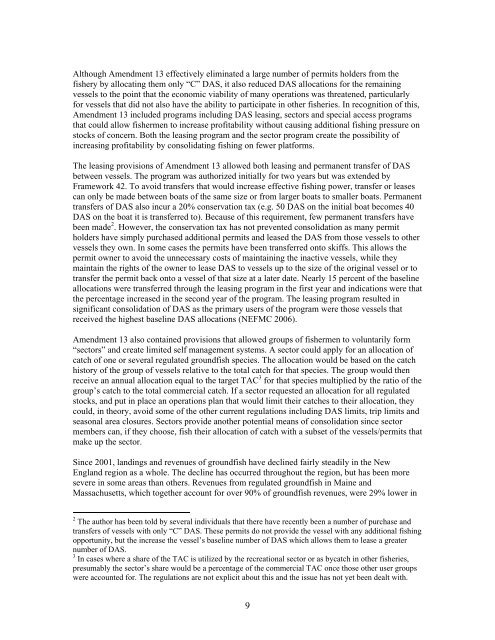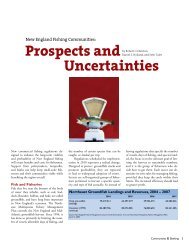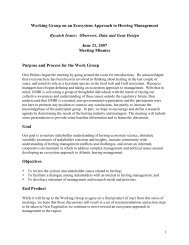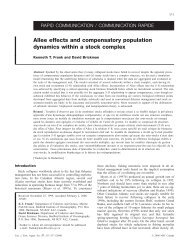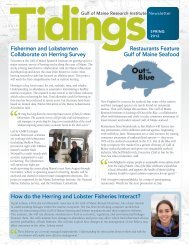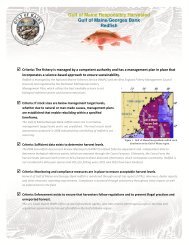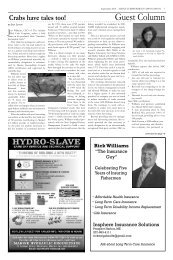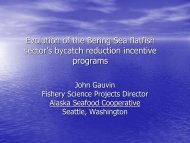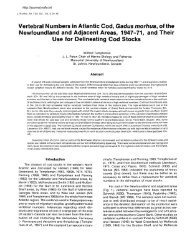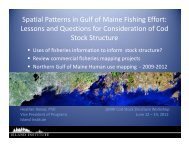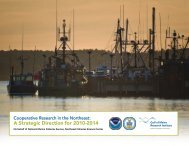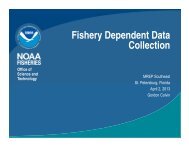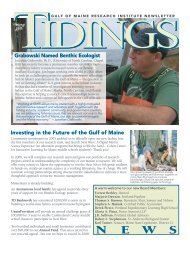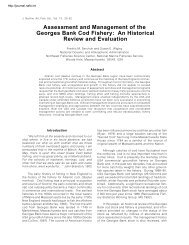Community-based Sectors for the New England Groundfish Fishery
Community-based Sectors for the New England Groundfish Fishery
Community-based Sectors for the New England Groundfish Fishery
You also want an ePaper? Increase the reach of your titles
YUMPU automatically turns print PDFs into web optimized ePapers that Google loves.
Although Amendment 13 effectively eliminated a large number of permits holders from <strong>the</strong><br />
fishery by allocating <strong>the</strong>m only “C” DAS, it also reduced DAS allocations <strong>for</strong> <strong>the</strong> remaining<br />
vessels to <strong>the</strong> point that <strong>the</strong> economic viability of many operations was threatened, particularly<br />
<strong>for</strong> vessels that did not also have <strong>the</strong> ability to participate in o<strong>the</strong>r fisheries. In recognition of this,<br />
Amendment 13 included programs including DAS leasing, sectors and special access programs<br />
that could allow fishermen to increase profitability without causing additional fishing pressure on<br />
stocks of concern. Both <strong>the</strong> leasing program and <strong>the</strong> sector program create <strong>the</strong> possibility of<br />
increasing profitability by consolidating fishing on fewer plat<strong>for</strong>ms.<br />
The leasing provisions of Amendment 13 allowed both leasing and permanent transfer of DAS<br />
between vessels. The program was authorized initially <strong>for</strong> two years but was extended by<br />
Framework 42. To avoid transfers that would increase effective fishing power, transfer or leases<br />
can only be made between boats of <strong>the</strong> same size or from larger boats to smaller boats. Permanent<br />
transfers of DAS also incur a 20% conservation tax (e.g. 50 DAS on <strong>the</strong> initial boat becomes 40<br />
DAS on <strong>the</strong> boat it is transferred to). Because of this requirement, few permanent transfers have<br />
been made 2 . However, <strong>the</strong> conservation tax has not prevented consolidation as many permit<br />
holders have simply purchased additional permits and leased <strong>the</strong> DAS from those vessels to o<strong>the</strong>r<br />
vessels <strong>the</strong>y own. In some cases <strong>the</strong> permits have been transferred onto skiffs. This allows <strong>the</strong><br />
permit owner to avoid <strong>the</strong> unnecessary costs of maintaining <strong>the</strong> inactive vessels, while <strong>the</strong>y<br />
maintain <strong>the</strong> rights of <strong>the</strong> owner to lease DAS to vessels up to <strong>the</strong> size of <strong>the</strong> original vessel or to<br />
transfer <strong>the</strong> permit back onto a vessel of that size at a later date. Nearly 15 percent of <strong>the</strong> baseline<br />
allocations were transferred through <strong>the</strong> leasing program in <strong>the</strong> first year and indications were that<br />
<strong>the</strong> percentage increased in <strong>the</strong> second year of <strong>the</strong> program. The leasing program resulted in<br />
significant consolidation of DAS as <strong>the</strong> primary users of <strong>the</strong> program were those vessels that<br />
received <strong>the</strong> highest baseline DAS allocations (NEFMC 2006).<br />
Amendment 13 also contained provisions that allowed groups of fishermen to voluntarily <strong>for</strong>m<br />
“sectors” and create limited self management systems. A sector could apply <strong>for</strong> an allocation of<br />
catch of one or several regulated groundfish species. The allocation would be <strong>based</strong> on <strong>the</strong> catch<br />
history of <strong>the</strong> group of vessels relative to <strong>the</strong> total catch <strong>for</strong> that species. The group would <strong>the</strong>n<br />
receive an annual allocation equal to <strong>the</strong> target TAC 3 <strong>for</strong> that species multiplied by <strong>the</strong> ratio of <strong>the</strong><br />
group’s catch to <strong>the</strong> total commercial catch. If a sector requested an allocation <strong>for</strong> all regulated<br />
stocks, and put in place an operations plan that would limit <strong>the</strong>ir catches to <strong>the</strong>ir allocation, <strong>the</strong>y<br />
could, in <strong>the</strong>ory, avoid some of <strong>the</strong> o<strong>the</strong>r current regulations including DAS limits, trip limits and<br />
seasonal area closures. <strong>Sectors</strong> provide ano<strong>the</strong>r potential means of consolidation since sector<br />
members can, if <strong>the</strong>y choose, fish <strong>the</strong>ir allocation of catch with a subset of <strong>the</strong> vessels/permits that<br />
make up <strong>the</strong> sector.<br />
Since 2001, landings and revenues of groundfish have declined fairly steadily in <strong>the</strong> <strong>New</strong><br />
<strong>England</strong> region as a whole. The decline has occurred throughout <strong>the</strong> region, but has been more<br />
severe in some areas than o<strong>the</strong>rs. Revenues from regulated groundfish in Maine and<br />
Massachusetts, which toge<strong>the</strong>r account <strong>for</strong> over 90% of groundfish revenues, were 29% lower in<br />
2 The author has been told by several individuals that <strong>the</strong>re have recently been a number of purchase and<br />
transfers of vessels with only “C” DAS. These permits do not provide <strong>the</strong> vessel with any additional fishing<br />
opportunity, but <strong>the</strong> increase <strong>the</strong> vessel’s baseline number of DAS which allows <strong>the</strong>m to lease a greater<br />
number of DAS.<br />
3 In cases where a share of <strong>the</strong> TAC is utilized by <strong>the</strong> recreational sector or as bycatch in o<strong>the</strong>r fisheries,<br />
presumably <strong>the</strong> sector’s share would be a percentage of <strong>the</strong> commercial TAC once those o<strong>the</strong>r user groups<br />
were accounted <strong>for</strong>. The regulations are not explicit about this and <strong>the</strong> issue has not yet been dealt with.<br />
9


